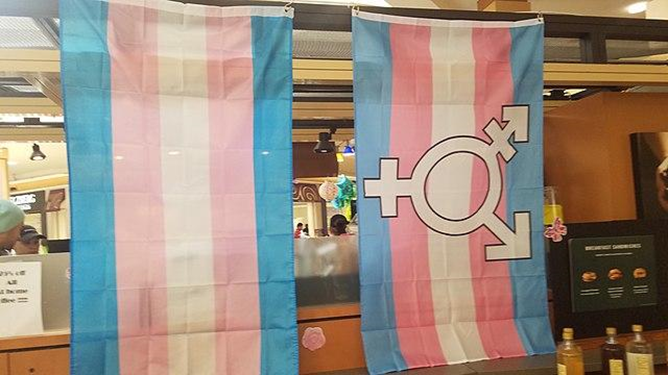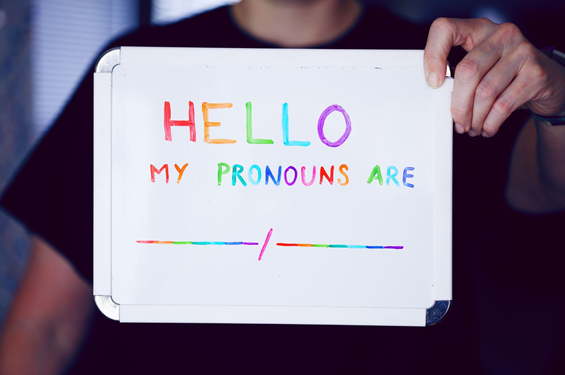5.5: Gender is a Spectrum
- Page ID
- 167190
A large number of people, including many transgender people, identify as either male or female. Others do not neatly fit into the categories of “man” or “woman,” or “male” or “female.” Some people have a gender that blends elements of being a man or a woman, or a gender that is different from either male or female. Others don't identify with any gender at all. Some people's gender changes over time.
People whose gender is not male or female use many different terms to describe themselves, with non-binary being one of the most common. Other terms include genderqueer, agender, bigender, and more. None of these terms mean exactly the same thing, and new terms are added occasionally, but all signify an experience of gender that is not simply male or female (Understanding non-binary people: How to be respectful and supportive, 2018).
A related aside: not all people who identify as transgender or outside the gender binary participate in hormone therapy or gender affirmation or confirmation surgery. Not only can hormone therapy and gender reassignment surgeries be expensive, many gender non-conforming people, do not wish to subject themselves to traditional markers of masculinity or femininity.
As is true for people in general, transgender women (TGW) have diverse levels of psychological androgyny (having both feminine and masculine characteristics). For example, five percent of the Samoan population are TGW referred to as fa'afafine, who range in androgyny from mostly masculine to mostly feminine (Tan, 2016); in Pakistan, India, Nepal, and Bangladesh, TGW are referred to as hijras (Figure 4.4), recognized by their governments as a third gender, and range in androgyny from only having a few masculine characteristics to being entirely feminine (Pasquesoone, 2014); and as many as six percent of biological males living in Oaxaca, Mexico are TGW referred to as muxes, who range in androgyny from mostly masculine to mostly feminine (Stephen, 2002).
Role of Sex Hormones in Transgender Treatment
Some transgender people do seek medical intervention to help align their bodies in a way that they feel represents who they are. One way this is done is through hormone therapy. Feminizing or masculinizing hormone therapy is the administration of exogenous endocrine agents to induce changes in physical appearance. Hormone therapy is inexpensive relative to surgery, and highly effective in the development of some secondary sex characteristics, such as facial and body hair in transgender men or breast development in transgender women. Thus, hormone therapy is often the first (and sometimes only) medical gender affirmation intervention accessed by transgender individuals looking to develop masculine or feminine characteristics consistent with their gender identity. In some cases, hormone therapy may be required before surgical interventions can be conducted. Transgender women are prescribed estrogen and testosterone blocking medication (such as cyproterone acetate and spironolactone). Transgender men are prescribed testosterone.

"Transgender day of visibility at Starbucks" by Breawycker is licensed under CC BY-SA 4.0
Violence and discrimination against people who exist within transgender and non-binary (NB) communities is at an all-time high. Even at a time when gender expression is becoming less of a taboo subject, and visibility and validation of identity is becoming more prevalent, the Human Rights Campaign reported that “2021 as one of the Deadliest Year on Record for Transgender and Non-Binary People”. From social stigma and intolerance leading transgender and NB people to take their own lives, to the outright murders of trans women particularly of color, their lives are often at risk of harm for no other reason than a desire to be seen as who they are and society not accepting them.
Certain regions of the United States can be very unsafe for transgender or NB people. In parts of the U.S. anti-trans legislation is popping up and conservative politicians seem to be uniting around denying them basic rights. As this type of gender policing picks up momentum in states all over the US, we will likely see an increase violence amongst LGBTQ+ people (specifically transgender and non-binary people) as they become further marginalized.
Trans Day of Visibility is an annual awareness day celebrated around the world. The day is dedicated to celebrating the accomplishments of transgender and gender nonconforming people, while raising awareness of the work that still needs to be done to achieve trans justice.



